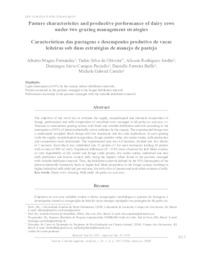Pasture characteristics and productive performance of dairy cows under two grazing management strategies.
Pasture characteristics and productive performance of dairy cows under two grazing management strategies.
Author(s): FERNANDES, A. M.; OLIVEIRA, T. S. de; JORDAO, A. R.; PACIULLO, D. S. C.; BAFFA, D. F.; CAMILO, M. G.
Summary: The objective of this work was to evaluate the supply, morphological and chemical composition of forage, performance and milk composition of crossbred cows managed in Megathyrsus maximus cv. Tanzania in intermittent grazing system with fixed and variable defoliation intervals according to the interception of 95% of photosynthetically active radiation by the canopy. The experimental design was a randomized complete block design with two treatments and two area replications. In each grazing cycle the supply, morphological composition, forage nutritive value, dry matter intake, milk production and composition were determined. The experimental area was 4.0 hectares, divided into two blocks of 2 hectares. Each block was subdivided into 22 pickets (11 for each treatment) totaling 44 pickets with an area of 909 m2 each. Significant differences (P < 0.05) were observed for leaf blade content, in vitro digestibility of dry matter and forage crude protein, dry matter intake, individual and area milk production and lactose content milk, being the highest values found in the pastures managed with variable defoliation interval. Thus, the defoliation interval defined by the 95% interception of the photosynthetically luminosity leads to higher leaf blade proportions in the forage canopy, resulting in higher individual milk yield and per unit area, but with a loss of protein and total solids contents of milk.
Publication year: 2020
Types of publication: Journal article
Unit: Embrapa Dairy Cattle
Keywords: Bovino, Dairy cows, Gado Leiteiro, Grazing, Megathyrsus maximus, Milk yield, Pastagem, Pastejo, Produção Leiteira
Observation
Some of Embrapa's publications are published as ePub files. To read them, use or download one of the following free software options to your computer or mobile device. Android: Google Play Books; IOS: iBooks; Windows and Linux: Calibre.
Access other publications
Access the Agricultural Research Database (BDPA) to consult Embrapa's full library collection and records.
Visit Embrapa Bookstore to purchase books and other publications sold by Embrapa.

